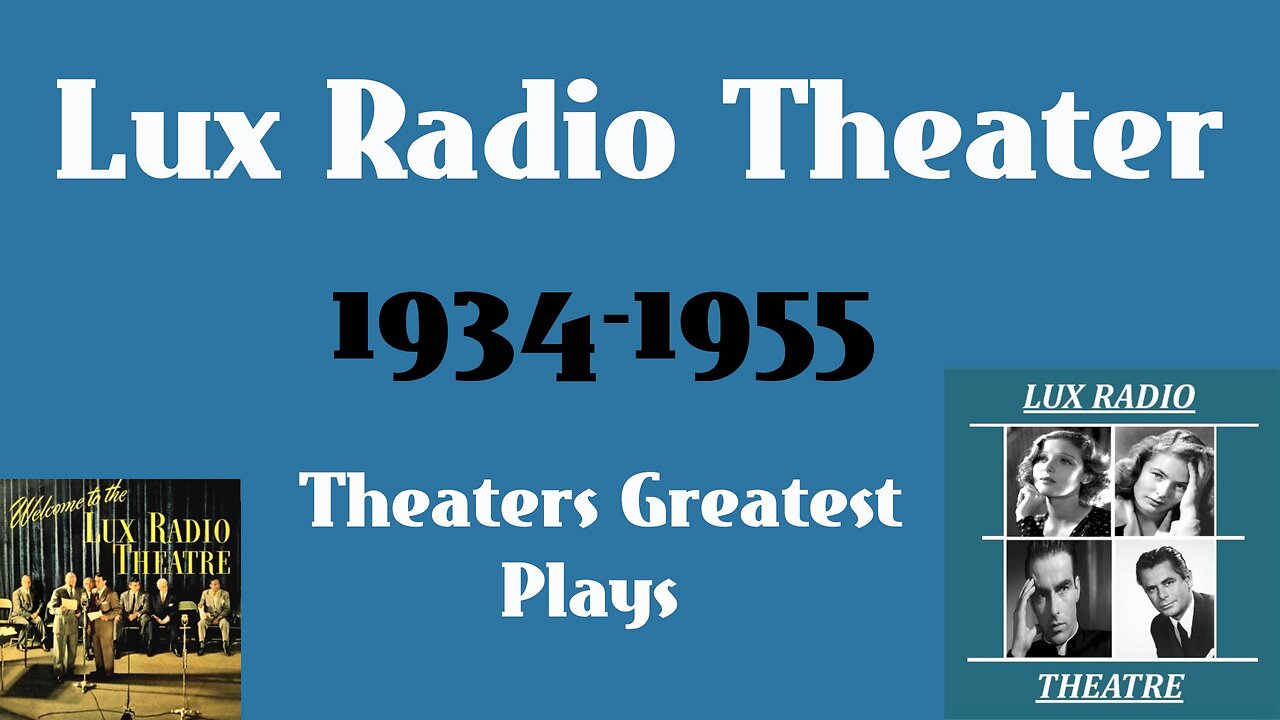Premium Only Content

Lux Radio 36-11-16 (ep107) Conversation Piece (Lily Pons, Adolphe Menjou)
Plot
The story is set in Regency Brighton in 1811. Paul, the Duc de Chaucigny-Varennes, an émigré from the terrors of the French Revolution, is passing off Melanie, a beautiful young girl, as his ward – the daughter of an executed friend, the Marquis de Tramont. In fact, Melanie is a dance hall singer. Paul's plan is to marry Melanie to a rich husband such as Edward, Marquis of Sheere, who seeks her hand.
The series begins with episode 52 Dulcy. None before this appear to exist.
Lux Radio Theatre was indisputably the biggest, most important, most expensive drama anthology program on radio. It ran from October 14, 1934, until June 7, 1955, then continued on television as Lux Video Theatre until 1957. In all, some 926 episodes were broadcast, providing a record of the most important entertainment events in American theatre and, later, film.
The show was first broadcast on the NBC Blue Network on Sundays at 2:30 PM. The show featured adaptations of successful Broadway plays when it was produced out of New York, such as Seventh Heaven, the first production starring Miriam Hopkins, Smilin' Through, Berkeley Square, Daddy Long Legs, Peg O' My Heart and Way Down East. On July 29, 1935, the show moved to Monday night at 9:00 PM on CBS, where it would stay until June 29, 1954.
The show moved to Hollywood on May 25, 1936 with the production of The Legionnaire and the Lady, based on the film Morocco, starring Marlene Dietrich and Clark Gable. The audience for this production was estimated as high as 40 million. The show featured many of the most important films of the period, adapted to fit the 60 minute time slot.
Some of the titles for 1939 should indicate the caliber and range of shows: Stage Door, Ceiling Zero, So Big, It Happened One Night, The Lives of a Bengal Lancer, Lady for a Day, The Life of Emile Zola, Tovarich, Only Angels Have Wings, The Prisoner of Zenda, The Awful Truth, Wuthering Heights, You Can't Take It With You, The Old Maid and Goodbye, Mr. Chips. For its last season, (1954-1955), the show moved to Tuesday nights at 9 on NBC.
Lux Radio Theatre was always broadcast live, with a studio audience and a full orchestra accompanying the performance and providing musical transitions between scenes. As many film actors were used to numerous takes and not live performance, they sometimes suffered acute stage fright before the show.
However, since most received $5,000 for their performance -- in addition to free publicity for upcoming pictures -- actors appeared in their original screen roles if they were available. Indeed, production would halt, if necessary, on a film if performers were called to appear on Lux. When the actors were not available, others stepped in.
The plays were assembled and rehearsed for a week, in sharp contrast to many other shows, which required a minimal of an actor's time. Regular players for the series included Jim and Marian Jordan, otherwise known as Fibber McGee and Molly. Hosts included Cecil B. DeMille (1936-1945), William Keighley (1945-1952) and Irving Cummings (1952-1955). Directors included Tony Stanford, Frank Woodruff, Fred MacKaye and Earl Ebi.
-
 LIVE
LIVE
Roseanne Barr
1 hour agoMAGA BITCHES!!!!! | The Roseanne Barr Podcast #73
7,162 watching -
 LIVE
LIVE
Nerdrotic
5 hours ago $44.64 earnedThe Great Hollywood MELTDOWN! A Culture War VICTORY Friday Night Tights 327 w/ Matthew Marsden
9,923 watching -
 LIVE
LIVE
Akademiks
1 day agoYoung Thug Declares war on Gunna? Donald Trump next President! 6ix9ine gets 60 Days in Jail.
4,767 watching -
 LIVE
LIVE
LFA TV
23 hours agoIt Was a Red Wave | Trumpet Daily 11.8.24 9PM EST
571 watching -
 10:24
10:24
Guns & Gadgets 2nd Amendment News
4 hours agoBREAKING NEWS: Illinois Assault Weapons Ban STRUCK DOWN!!!
7462 -
 1:24:47
1:24:47
vivafrei
4 hours agoArizona Chicanery! Iran Plot! Canada McCarthyism AND MORE!
58.9K62 -
 1:16:02
1:16:02
Candace Show Podcast
4 hours agoFormer CIA Officer Exposes The Shadow Government | Candace Ep 100
104K198 -
 34:37
34:37
Stephen Gardner
4 hours ago🔥Trump sends SHOCKWAVES with TERRIFYING New Threat + Biden BACKSTABBED Kamala with POWER PLAY!!
50.2K47 -
 1:52:32
1:52:32
2 MIKES LIVE
4 hours ago2 MIKES LIVE #140 Open Mike Friday
34.6K -
 24:39
24:39
RealitySurvival
5 hours agoDon't Ignore The Warning Signs Of The Chaos Still To Come!
22.2K1